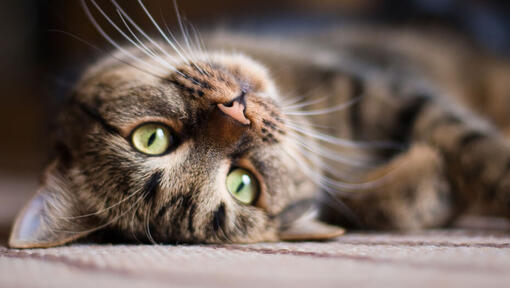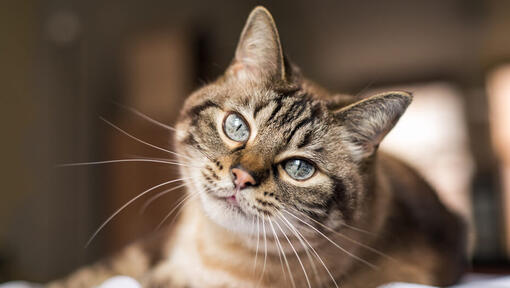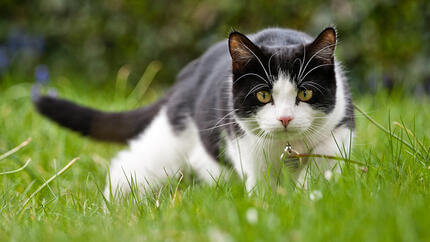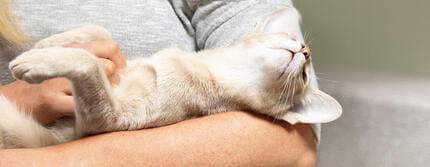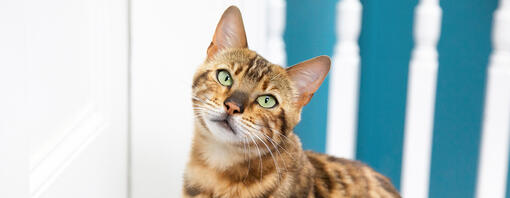
Whiskers do a lot more than making your kitty look cute, they also serve many important purposes! From working as a built-in measuring tape to helping with their close-up vision, your cat's whiskers are truly amazing!
Your cat’s whiskers are an iconic part of their anatomy. Not only do they look incredibly cute and tickle us during the night, but they also have an important purpose. Serving as the ultimate sensory tool, their whiskers are nothing like hair (although they might look like it) and are actually highly sensitive.
You may be wondering why do cats have whiskers and want to find out more about your fuzzy friend’s built-in radar system. Keep reading to discover everything about whiskers, from how they work to how they help cats navigate in the dark!
Why do cats have whiskers?
Your cat’s whiskers are truly multifunctional, but their most important purpose is as a sensory tool. The official title for them is vibrissae, which comes from Latin ‘vibrio’ and means ‘to vibrate’. The hair follicle of your cat’s whiskers is loaded with nerves, and the whisker tip features a sensory organ known as a proprioceptor. Together, this makes them incredibly sensitive to vibrations and changes in their environment, so cats use them like an additional sense to understand the world.
Additionally, whiskers are also much more deeply embedded in their body than normal fur hair, as they’re connected to the muscular and nervous system. This enables whiskers to send sensory messages to the brain about your cat’s surroundings, which is what makes them such savvy explorers!
We think cat’s whiskers are, well, the cat’s whiskers. Which is why we’ve put together our top 10 facts to tell you everything you need to know about your clever cat’s face fuzz:
1. Cat’s whiskers aren’t just on their face
Where you may think that your cat’s whiskers are limited to just around their nose, they’re also above their eyes, ears, jaw and forelegs!
The whiskers on their forelegs (carpal whiskers) are one of the reasons they’re such successful hunters as they help to determine the movement of prey.
2. Whisker distribution is symmetrical
Cats have an even number of whiskers on their muzzle with 24 in total. Each side has 12 whiskers in a completely symmetrical distribution, so they can accurately measure the environment.
3. Built-in measuring tape
You may have seen your cat put their head into an opening before the rest of their body. This is because their whiskers work as a built-in ruler! Because whiskers are placed around the width of your cat’s body, it means they are excellent at helping your cat gauge how tight a space is.
4. They work as vibration sensors
Your cat’s whiskers can sense vibrations in the air, making them incredibly useful when measuring distances or chasing prey. Additionally, they can also detect changes in air currents, enabling them to sense approaching dangers – making them sort of like their very own radar.
5. They help with close-up vision
It may surprise you to learn that your cat’s close-up vision isn’t very good and they can’t easily see anything closer than 30cm in front of them. They use their whiskers to navigate the world straight ahead, as by touching them against an object they can tell where it is, its size and even the texture.
6. Whiskers are night vision aids
If you’ve ever wondered how your cat seamlessly moves around during the night without bumping into anything, it is in part because of their whiskers! The air currents in a room are different depending on where furniture is placed and their intelligent whiskers pick up on this and tells their brain where things are. Pretty cool, right? This, combined with cat’s having much better night vision than humans, means they are much more able to navigate their way around in the dark than their owner would be able to!
7. Whiskers tell you how they’re feeling
Whiskers can give you an insight into a cat’s behaviour or emotions. If their whiskers are rigid and pulled around their face it means they may feel threatened, whereas, if their whiskers are relaxed, it indicates that your cat may be feeling happy and content. Additionally, if you notice that your cat’s whiskers are pushed forward it may mean that they’re interested or curious.
8. They give purrfect protection
Your cat’s whiskers also serve to protect your cat’s sensitive spots from possible danger or injury. The whiskers around their eyes respond to the tiniest touch (even a small speck of dust), allowing your kitty to shake or blink to remove it.
Also, when your cat is outside exploring the world, their whiskers will detect sharp things first, offering essential protection to their eyes and face.
9. They can change colour
Just like we go grey with age, your cat’s whiskers can also show the signs of ageing too! It doesn’t always happen, but sometimes their snowy white whiskers can appear to change to dark grey or even black.
10. They should never be trimmed
You should never, ever, cut your cat’s whiskers. They are vital for so many things that if you snip them off, your cat can get very disorientated and scared as they’ll be unable to gauge or sense their environment. Don’t worry if you find one or two that have fallen out though, they do grow back!


